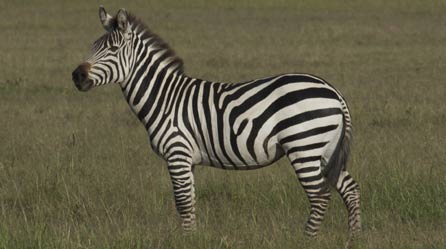GENERAL
INFO
The Plains zebra is the
most commonly know zebra. It is characterized by short legs and fat
squatty body. Unlike other zebras, Plains zebras have vertical stripes on
the bum.
SPECIAL FEATURES
- Zebras are naturally attracted to things with black and white
stripes, even if they aren't living things zebras will naturally go to
it
- Zebras smile, much like humans, to ward off aggressive
feelings
- The night vision of a zebra is said to be comparable to that of an
owl or cat
- Each zebra has its own pattern of stripes, kind of like a human
finger print
HABITAT
The Plains Zebra can
be found in areas like savannas and grasslands. They prefer regions that
have annual rainfall because they depend on grazing. For this reason they
would not be found in South Dakota nor would they be found in the United
States unless they're in cage at a zoo. Mainly zebras are in the lower
part of Africa. These regions are open ranges, offering lots of space and
plenty of vegetation, not the desert like the northern region.
DIET
Plains zebras are
herbivores; they feast on a variety of grasses. They spend sometimes up to
sixteen hours of their day grazing. Unlike some animals, they don't have
to worry much about competing for food, in fact the part of the
grass that the zebra consumes serves no use to other animals who just come
behind the zebra and finish the rest. During periods of harsh
weather, such as periods of drought, zebras migrate to find water.
THE HAREM
Zebras travel in
what's called a harem. Harems include one male among many females, usually
averaging about 7 members to a harem. Males normally start out in a
bachelor group, which is just a group of males looking for females to
dominate. Sometimes while the male is looking for a female he will venture
out alone, but this is very rare. The job of the male is to protect the
female.Males protect females from predators and also from other males.
Protection relates a a lot with reproduction, if a female is well
protected, she has easier access to graze, which also leads to a better
chance of being impregnated. These harems are permanent groups kind of
like families. The harems mingle with each other by maybe grazing on the
same area of land, but each zebra identifies with its own
"family". Zebras can also differentiate between members of their
own harem based on stripes, voice, and scent. Bonds are made stronger by
group grooming.
REPRODUCTION
Zebras are mammals so they are viviparous. They do not lay
eggs but nourish their young through placenta inside mother. A baby
remains inside the mother for a period of 370 days, after which the baby
is born precocial, able to walk and nurse within a couple of hours. After the baby is born, the mother of the newborn foal wards off any outsiders,
including members of the harem, so the baby may learn and be able to
identify its mom. After the baby has grown and is able to be out on
"its own" it will leave its birth harem, females will be
accepted into new harems and males joining bachelor groups waiting to find
a harem.
HUMAN
IMPACT
Plains zebra are one of the only breed of zebras
not endangered by humans. Zebras biggest enemy is the lion, and as defense
against this overgrown cat zebras will form a semi-circle facing the
predator. If approached by the predator, zebras will bite the legs and
face of the attacker.
|

